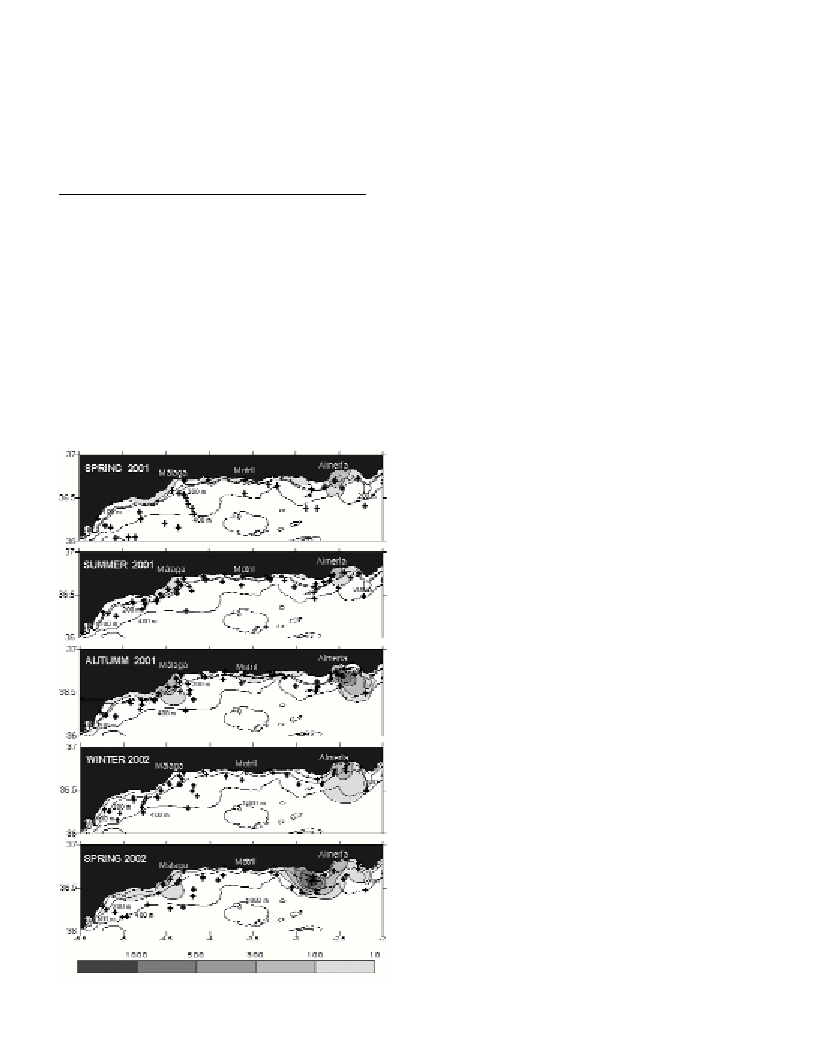SEASONAL RECRUITMENT OF HAKE IN THE ALBORAN SEA (SW MEDITERRANEAN)
Rey J.*, del Árbol J., Gil de Sola L.
Instituto Español de Oceanografía, Málaga, Spain - *javier.rey@ma.ieo.es
Abstract
In this study, the recruitment of the European hake (Merluccius merluccius) in the Alboran Sea was examined based on data collected from
five trawl surveys carried out on the shelf and upper slope of the Alboran Sea during 2001-2002. Abundance of recruits was highest in
spring 2002 and autumn 2001 at depths between 100 and 200 m.
Key words: hake, recruitment areas, Alboran, Mediterranean
Rapp. Comm. int. Mer Médit., 37,2004
427
Introduction
The catches of hake in the Alboran Sea are derived almost exclu-
sively from trawl fishing and composed mainly of juveniles. The
description of the main recruitment areas and recruitment variability
are important for managing this resource, which is targeted by the
Alboran trawl ?eet (1)
Material and methods
This study is based on data obtained from five seasonal trawl sur-
veys carried out in the Alboran Sea. Two of them were conducted by
the R/V Cornide de Saavedraduring spring 2001 and 2002 (MEDITS
time series: 2). The remaining ones were conducted by the R/V Fco.
de Paula Navarroduring summer, autumn and winter between both
spring cruises. A total of 190 hauls were made in the study area at
depths ranging from 40 to 796 m, based on random stratified sam-
pling. A GOC73 gear with a mesh size of 40 mm was used in every
survey following the same protocol (2). Catches were standardized
per 1h of trawling and abundances were weighted to the number of
fish per trawling hour. The spatial representation of recruit abundance
was analysed using geostatistis (ordinary kriging method: 3). Nodes
each 5x5 nautical miles were considered for density estimations and
spherical variograms were fitted, using SURFER 7.0 software.
Results and discussion
Hake recruits were concentrated mainly between 100 and 200 m,
although individuals of total lengths up to 17 cm were found between
42 and 261 m.
The highest abundances were recorded in spring 2002 and autumn
2001, with maxima of 1800 and 1400 recruits/h, respectively.
Maximum abundance in winter 2002, and spring and summer 2001,
was 340, 280 and 180 recruits/h, respectively. Throughout the whole
year maximum abundances were reached in the eastern part of the
Alboran Sea.
Although individuals with lengths <17 cm were found at all sta-
tions, they dominated the spring and autumn 2001 catches, compris-
ing >80% of the total number of specimens caught. In spring 2002,
juveniles made up 99% of the total catch by number.
In the Iberian Mediterranean (from Gibraltar to cape of Creus), the
recruitment of hake increases with latitude, with the highest concen-
trations found at the Catalan shelf (4).
Some studies have pointed out that hake recruitment strength is
strongly in?uenced by oceanographic variables in the Atlantic (5) and
the Mediterranean (6). The exceptional circulation pattern in the
Alboran Sea (7) should explain anyhow these results though further
studies are needed in the area in order to improve the management of
this target species.
References
1-Gil de Sola L., 1993. Las pesquerías demersales del mar de Alborán
(surmediterráneo ibérico). Evolución en los últimos decenios. Informes
Técnicos del Instituto Español de Oceanografía, 142: 179 p.
2-Bertrand J.A., Gil de Sola L., Papaconstantinou C., Relini G., and
Souplet A., 2002. The general specifications of the MEDITS surveys.
Scientia Marina, 66 (suppl. 2): 9-17.
3-Petitgas P., 1996. Geostatistics and their applications to fisheries survey
data. Pp. 113-142. In: Megrey, B. A. and Moksness E. (ed.), Computers in
fisheries research. Chapman & Hall Publ., London.
4-Relini L., Papaconstantinou C., Jukic-Peladic S., Souplet A., Gil de
Sola L., Piccinetti C., Kavadas S. and Rossi, M., 2002. Distribution of the
Mediterranean hake populations based on six years monitoring by trawl-
surveys: some implications for management. Scientia Marina, 66
(suppl.2): 21-38.
5-Sánchez F., and Gil J., 2000. Hydrographic mesoscale structures and
Poleward Current as a determinant of hake (Merluccius merluccius)
recruitment in southern Bay of Biscay. ICES Journal of Marine Science,
57: 152-170.
6-Maynou F., Lleonart J., and Cartes J. E., 2003. Seasonal and spatial
variability of hake (Merluccius merlucciusL.) recruitment in the NW
Mediterranean. Fisheries Research, 60: 65-78.
7-Parrilla G., and Kinder T. H., 1987. Oceanografía física del mar de
Alborán. Bol. Inst. Esp. Oceanogr., 4(1): 133-165.
Fig. 1. Seasonal distribution of hake recruits (<17 cm) expressed as
number of individuals per trawling hour.

